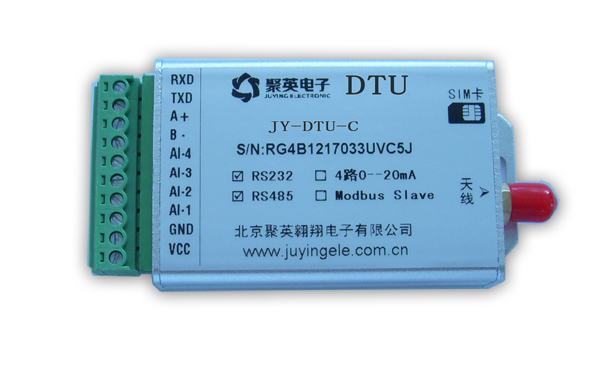GPRS DTU is a wireless data terminal of Internet of things, which provides users with wireless long-distance data transmission function by using public operator network GPRS network (also known as G network) It adopts high-performance industrial 8 / 16 / 32-bit communication processor and industrial wireless module, takes the embedded real-time operating system as the software support platform, and provides RS232 and RS485 (or RS422) interfaces, which can be directly connected to the serial port equipment to realize the transparent data transmission function.
The figure below shows GPRS DTU jy-dtu-g

CDMA DTU, also known as 3G DTU, adopts ARM9 high-performance industrial grade embedded processor, takes real-time operating system RTOS as the software support platform, has large memory, and is embedded with TCP / IP protocol stack with perfect independent intellectual property rights. Provide users with high-speed, stable and reliable transmission mode, the data terminal is always online, and support the virtual private network with high security and multi protocol conversion. For users of network flow control, the product supports the functions of voice, short message, data trigger on-line and timeout automatic disconnection. At the same time, it also supports the backup of dual data centers and the synchronous receiving of data by multiple data centers.
The following figure shows CDMA DTU jy-dtu-c

What is the difference between GPRS DTU and CDMA DTU?
CDMA adopts GPRS-DTU transmission rate, CDMA adopts GPRS-DTU transmission rate, CDMA adopts GPRS-DTU transmission rate, and CDMA adopts GPRS-DTU transmission rate of 20-bit, DTU transmission rate of DTU, and CDMA adopts DTU transmission rate of DTU to DTU.
GPRS DTU and CDMA DTU have the characteristics of low construction difficulty, short construction period, low use price and maintenance cost, and both of them have high reliability.
2. Automation of the city's transportation network, automation of the city's transportation network, management of the city's transportation network, and management of the city's transportation network, electronic traffic network, and POS Logistics management, taxi management, vehicle scheduling, e-commerce, mobile Internet.

 Manager Wang
Manager Wang
 OfficialAccounts
OfficialAccounts